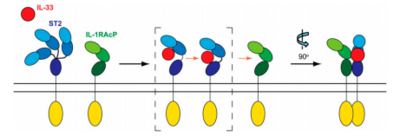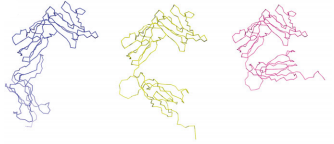Introduction
Interleukin 33 is a cytokine member of the interleukin 1 superfamily. Cytokines are proteins involved in cell signaling. Their role is to regulate the function and the activity of other cells. IL-33 is involved in innate and adaptive immune responses.
In 2005, IL-33 was identified as a ligand for the transmembrane receptor ST2 (also known as IL1RL1 and it IL-1 receptor accessory protein (IL-1RAcP) as you see below, both members of the interleukin-1 receptor family. IL-33/ST2 signaling is involved in T-cell immune responses.

We will focuse on the interaction bewteen IL33 and the ST2 ectodomain (as you can see ).
Function
Caracteristics of IL-33
IL-33 is constitutively expressed in several cells, such as epithelial or endothelial cells. IL-33 is also expressed in an inducible way by immune cells. In this case, the constitutive expression of IL-33 is very low or absent. In mast cells, the expression of IL-33 is induced by the calcium, but the mechanisms are still unclear. IL-33 is secreted in damaged tissues, where it activates the immune response.
Target cells
ST2 exists in a soluble form (sST2) and a transmembrane form (ST2L). The both forms can interact with IL-33. ST2L are expressed in T lymphocytes, when these lymphocytes are specializing into Th2 cells (T helper type 2 cells, a specific type of T lymphocytes). This specialization occurs in the presence of IL4, expected to be secreted by polynuclear basophils.
IL-33 interacts with the ectodomain of ST2L on Th2 cells. This interaction provokes the recruitment of the myeloid differentiation primary-response protein 88 (MYD88) complex, which is involved in the immune response against commune viral infections and some bacterial infections.
When IL-33 interacts with the sST2, it inhibits the fixation of IL-33 with the ectodomain of ST2.
Structure
Overall structure
The understanding of the interaction of IL-33 with its receptors has been discovered thanks to the determination of the crystal structure of IL-33 in complex with ectodomain of ST2.
Besides, the combination of crystallography and small-angle X-ray-scattering methods reveal that ST2 has a very flexible conformation, contrary to IL-1RAcP. In fact, ST2 is constituted of three IgG-like domains (). D1 and D2 gather to form a single D1D2 module, connected through a linker with the D3 domain. The flexibility of these domains allows ST2 to exist in three different conformers, as you can see on the image below.

On the left and on the right, there are respectively the open conformer and the close conformer of ST2. On the middle, the half-open conformer is shown. This conformer superimposes perfectly with the conformation of ST2 bound with IL-33.
This conformational specificity provides a capactity of ligand-binding with IL-33. Moreover, the rigidity of IL-1RAcP explains that it can not bind the IL-33 ligand directly.
ST2 contains also linked with NAG and an which is involved in the interaction with the other receptor, IL-1RAcP.
In humans, IL-33 in its full length is composed of 270 residues and is biologically active.
The model includes IL-33 residues Ser117 to Ser268 and ST2 residues Ser21 to Arg317.
The structure of IL-33 consists in a forming a β-trefoil structure. It also contains an . Specific loops, such as the β4-β5 loop, are involved in the interaction with the accessory receptor IL-1RAcP when IL-33 is bound to ST2.
IL-33/ST2 interactions
In the complex, IL-33 interacts with the three domains of ST2. The binding interface is very large and composed of two separate sites.
In the , thirteen IL-33 residues from β-loops are in contact with the D1D2 module of ST2: the four marked acids residues of IL-33 form a salt-bridge with five marked ST2 residues respectively. Besides, form hydrogen bonds with main-chain atoms of ST2. IL-33 mutation of one of the acid residues (144, 148, 149 and 244) highly decreases the affinity of ST2 for IL-33.
In the , eight IL-33 residues from β-strands interact with the D3 domain of ST2.
There are both hydrophobic and hydrophilic interactions. Residues of IL-33 form an hydrophobic cluster (IL-33 residues Tyr163 and Leu182 and ST2 residues Leu246, Leu306, and Leu311). A salt-bridge interaction occurs between acidic residue respectivevly of IL-33 and ST2.


